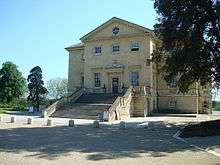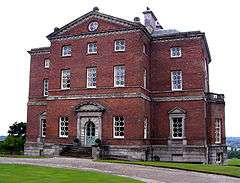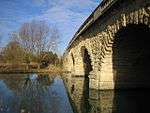Robert Taylor (architect)
Sir Robert Taylor (1714–1788) was an English architect who worked in London and the south of England.
Sir Robert Taylor | |
|---|---|
 The Guildhall, Carmarthen by Sir Robert Taylor 1767–77 | |
| Born | 1714 Woodford, Essex |
| Died | 27 September 1788 |
| Nationality | English |
| Occupation | Architect |
| Buildings | Bank of England Heveningham Hall Gorhambury House |
Early life
Born at Woodford, Essex, Taylor followed in his father's footsteps and started working as a stonemason and sculptor, spending time as a pupil of Sir Henry Cheere.[1] Despite some important commissions, including a bust of London merchant Christopher Emmott (died 1745) today held in the church of St Bartholomew, Colne, Lancashire,[2] and another of William Phipps (died 1748), now in the parish church of Westbury, Wiltshire, he enjoyed little success and turned instead to architecture.
Career
Among Taylor's earliest projects was Asgill House (known then as Richmond Place), built for a wealthy banker, Sir Charles Asgill, in Richmond upon Thames (c. 1760), and nearby Oak House. Through such connections, he came to be appointed as architect to the Bank of England until his death, when he was succeeded by Sir John Soane. In 1769 he succeeded Sir William Chambers as Architect of the King's Works. His pupils included John Nash, Samuel Pepys Cockerell, George Byfield and William Pilkington.
In 1783, he served as a Sheriff of London and was knighted the same year.[3]
Sir Robert served as a vice president on the board of the Foundling Hospital, a prominent charity dedicated to the welfare of London's abandoned children.
Personal life
Taylor and his wife Elizabeth (d. 1803)[4] had a son, Michael Angelo Taylor (1757–1834), who, as MP for Poole, became a Whig politician during the 1830s. His death was caused by catching a chill at his friend Asgill's funeral in September 1788. Father and son were both buried in the church of St Martin-in-the-Fields in Trafalgar Square, London. Taylor is commemorated in Poets' Corner, Westminster Abbey.
Legacy
The Taylor Institution, Oxford University's centre for the study of medieval and modern European languages and literature, takes its name from a bequest from Taylor for the purpose of "establishing a foundation for the teaching and improving the European languages". The money was initially invested and interest left to accrue to cover building costs.[1]
The Sir Robert Taylor Society is an organisation which seeks to bring together modern language teachers in schools and university lecturers from the Faculty of Medieval and Modern Languages, University of Oxford. A meeting is held once a year, shortly before the start of the Michaelmas term, at which talks are held on the literature and culture of the language communities represented in the Oxford faculty, and university admissions trends in the various languages are discussed.[5]
Architectural works
From Binney's book:[6]
- 14 St. James's Square, London, alterations (1748–50)
- 112 Bishopsgate, City of London (c. 1750); demolished
- Braxted Lodge, Essex, extension (1752–56)
- Bishop's Palace, Chester, remodelled (1754–57); demolished 1874
- 35 & 36 Lincoln's Inn Fields, London (1754–57); 36 rebuilt 1859, 35 bombed in the Blitz 1941
- Mausoleum, Chilham Church (1754); demolished 1862
- Harleyford Manor, near Marlow, Buckinghamshire (1755)
- Coptford Hall, nr. Margaretting, Essex (1755); demolished 1850
- Comarques, Thorpe-le-Soken, Essex, later the home of the novelist Arnold Bennett[7]
- London Bridge, removal of houses on the bridge and replacement of the central two arches by a single arch (1756–66); demolished 1831
- Barlaston Hall, Staffordshire (1756–57)
- The Grove, Watford, Hertfordshire remodelling (1780)
- 70 Lombard Street, London (c. 1756); demolished c. 1920
- Pond House, Village Way, Dulwich (1759 – still standing) was designed in 1759 by Sir Robert Taylor for John Tinkler as a hunting lodge. Exceptional original features include gold cornicing in the drawing room and exquisite mouldings in the dining room depicting Roman and Greek themes
- Grafton House, Piccadilly (c. 1760); demolished 1966
- Longford Castle, alterations (c. 1760)
- Ottershaw Park, nr. Chertsey, Surrey (1761); demolished 1908
- Asgill House, Richmond, Surrey (1761–64)
- Danson House, Bexley, Kent (1762–67)
- Trewithan House, dining room and other additions Cornwall (1763–64)
- Bank Buildings, Threadneedle Street, City of London (1764–66); demolished 1844
- Bank of England, Rotunda & Transfers office (1765–68), Court Room & associated offices (1765–72), Reduced Annuity Office (1787); demolished apart from the Court Room which was incorporated into the current building
- Arnos Grove house in Cannon Hill, Southgate north London, library & dining room (c. 1765)
- 34 Spring Gardens, Charing Cross, London, Taylor's own house (1767); demolished 1885
- Kevington, enlarged, St Mary Cray, Kent (1767–69)
- Six Minor Bridges on the Botley Road, Oxford (1767); none survives
- Swinford Bridge, over the River Thames at Eynsham (1767–69)
- 33 Upper Brook Street, Mayfair, London (1769)
- 1 to 14 Grafton Street, London (1769 onwards); only 3 to 6 and the basement of 7 survive
- Chute Lodge, Wiltshire, near Andover (c. 1768)
- Purbrook Park, Portsdown Hill, Hampshire (c. 1770) – the first recreation of a Roman atrium in England; demolished 1829
- Sharpham House, nr. Totnes, Devon (c. 1770)
- The Oaks, the ball room, attributed, Carshalton, Surrey (c. 1770)
- The Bishop's Palace Ely, alterations (1771); little of the work survives
- Althorp, Northamptonshire, repairs to the roof (1772)
- Thorncroft, Leatherhead, Surrey (1772)
- Spencer House, London, decoration of staircase ceiling (1772)
- Mount Clare, Roehampton (1772)
- Maidenhead Bridge, Berkshire (1772–77)
- Ely House, Dover Street, Mayfair, London (1772–1776); interior remodelled 1909
- Porter's Lodge, Shenley, Hertfordshire (1772); altered 1903
- Stone Buildings, Lincoln's Inn, London (1774–80)
- Six Clerk's and Enrolment Offices, Chancery Lane, London for Lincoln's Inn (1775–77)
- Assembly Rooms, Belfast, Northern Ireland (1776); exterior altered 1845, interior altered 1895
- Spire of St Peter's Church, Wallingford (1776–77)
- Heveningham Hall (1777 – c. 1780), interiors by James Wyatt (c. 1780 – 1784)
- Gorhambury Manor, St Albans (1777–90) altered 1816–17, 1826–28 and 1847
- Church Long Ditton, Surrey (1778); demolished 1880
- Bishop's Palace, Salisbury, alterations including gothic porch, doors, windows and chimneypiece (1982)
- Admiralty House, London (1786–88) interiors by Samuel Pepys Cockerell
- Salisbury Guildhall (1788–95) executed after Taylor's death by his pupil William Pilkington
- House in Whitehall Yard, London for his son (1788), built 1793
- 15 Philpot Lane, London, date unknown
- Clumber Park, Nottinghamshire, a room with columned screens at either end, date unknown, demolished 1938
Further works, not listed in Binney's book as by Taylor:
- alterations to Bayley Park, Heathfield, East Sussex (1766)
- Kevington Hall, near Orpington, Kent (1767–1769)
- Beckenham Place Park, Kent (1773)
- Clermont Lodge, Norfolk (1769–1775)
- alterations to 10 Downing Street, London SW1 (c. 1780)
Gallery of architectural work
- Asgill House, Richmond
 Danson House, Kent
Danson House, Kent Danson House, Kent
Danson House, Kent Salisbury Guildhall
Salisbury Guildhall Barlaston Hall, Staffordshire
Barlaston Hall, Staffordshire Gorhambury House
Gorhambury House Swinford Bridge
Swinford Bridge.jpg) Ely House, Dover Street, Westminster
Ely House, Dover Street, Westminster Bank of England, showing one of Taylor's wings, demolished
Bank of England, showing one of Taylor's wings, demolished Reduced Annuity Office, Bank of England, demolished
Reduced Annuity Office, Bank of England, demolished- Mount Clare, Roehampton, London
.jpg) Heveningham Hall
Heveningham Hall
References
- . Dictionary of National Biography. London: Smith, Elder & Co. 1885–1900.
- Sir_Robert_Taylor's_Foundation Archived 2008-10-03 at the Wayback Machine
- Lancashire Churches - Colne Archived 2007-11-04 at the Wayback Machine
- Gorton, John. A general biographical dictionary, Volume 3. Google Books
- "Nos. 60-64, Charing Cross and Nos. 3, 5, 7 and 9, Spring Gardens Pages 131-135 Survey of London: Volume 16, St Martin-in-The-Fields I: Charing Cross. Originally published by London County Council, London, 1935". British History Online. Retrieved 20 July 2020.
- "About the Society". Sir Robert Taylor Society. Retrieved 5 July 2015.
- Binney, Marcus (1984) Sir Robert Taylor from Rococo to Neo-Classicism, George Allen & Unwin, London. ISBN 0-04-720028-6. Pages 94-97.
- Historic England. "Comarques (Grade II*) (1112108)". National Heritage List for England. Retrieved 7 June 2020.
| Wikimedia Commons has media related to Robert Taylor (architect). |